Designing Schools for a Modern Learning Environment
How flexible layouts and technology in the classroom better prepare today’s students for their future
![]() Continuing Education
Continuing Education
Use the following learning objectives to focus your study while reading this month’s Continuing Education article.
Learning Objectives - After reading this article, you will be able to:
- Describe why and how schools are changing to better engage students and teachers.
- Discuss how classrooms are evolving for better learning environments.
- Define how furnishings in new classrooms add to superior learning.
- Describe green and sustainable elements in modern classrooms.
- List technology elements suited for a high-impact classroom.
When President Lyndon B. Johnson stated in his famous “Great Society” speech of 1965, “More classrooms and more teachers are not enough. We must seek an educational system that grows in excellence,” he knew then what still know now: Education is key to a great society, and new strategies are necessary.i
The term “old school” is fine for classic guitars, rock groups and vintage timepieces. The term denotes something old-fashioned that has maintained its value. But when describing schools and classrooms, a modality evolved from an old and tired classroom teaching style, basically unchanged for more than a century, is desperately needed. Fading away is the staid, static modus operandi of one wall with a chalkboard and a teacher’s desk at the front of the room, desks lined up in rows facing forward, with students passively receiving information.
The connected, interactive, globally oriented world students will enter as adults calls for more than rote memorization skills and the ability to sit still and follow directions. The challenging future these students will face demands collaborative skills, relevant uses of technology, the ability to think through problems and the ability to see the interconnectedness of major disciplines—science, technology, engineering, arts and math (STEAM).
But new teaching styles require more than just new teacher skills. The new paradigm demands a change to the very layout of these schools, a rethinking of how schools and classrooms are designed, how classroom functions shift and change and flow as the lesson or activity dictates.
The influence of designers and architects in creating new schools and classrooms cannot be overemphasized. Architecture has always “taught” and informed occupants. The entrance architecture tells occupants where to enter the building. The layout and walls and openings and furnishing instruct occupants how to move through a building, where to pause and where to stop. The design of forward-thinking schools likewise informs the occupants and helps direct the activities therein.
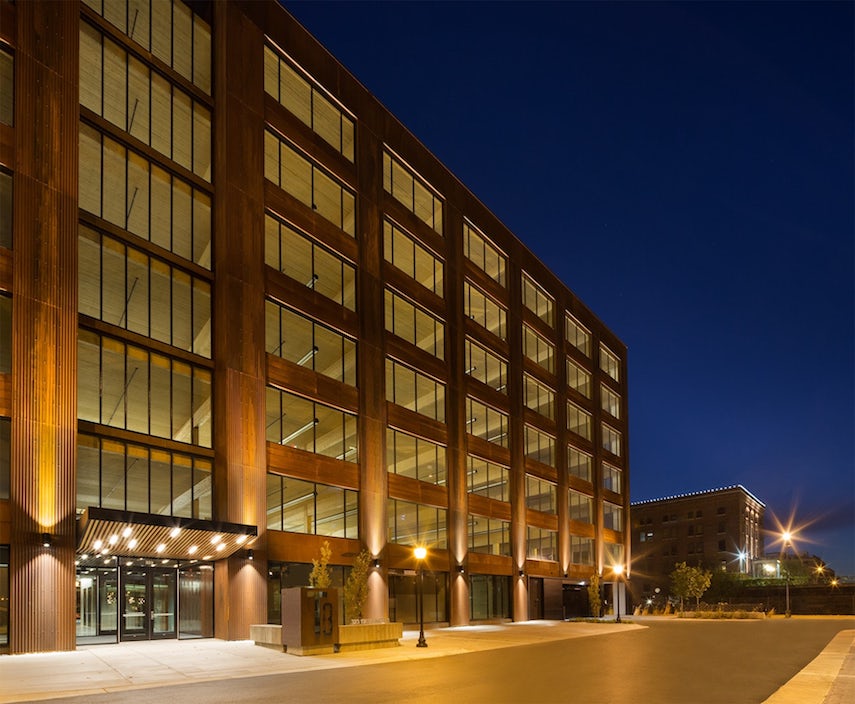
Image courtesy of MooreCo Inc.
A modern learning environment calls for flexible seating and room layout for different teaching and learning activities.
Driven partly by technology and mirroring the open concept layout of today’s innovative corporate campuses, intelligently designed classrooms for high-impact learning will better equip students for their collaborative future workplaces, and for solving the world’s complex problems. This course will educate architects, designers and others about what makes up forward-thinking schools and classrooms and how to design, specify for and furnish them.
Why and How Schools Are Changing to Active Learning Environments
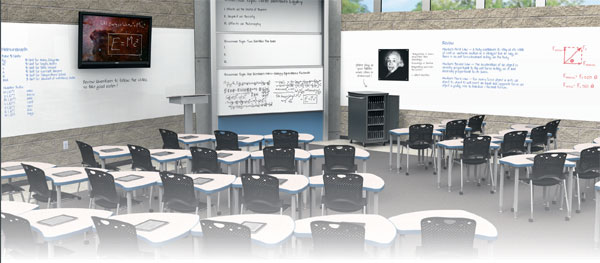
Image courtesy of MooreCo Inc.
Even when seats are arranged in a somewhat traditional lecture format, the teaching surfaces and technology the instructor uses to convey lessons is highly advanced from just a few years ago.
There are many reasons to change our education systems. Preparing today’s students for the future presents new challenges, based on such factors as globalization, technology, migration, international competition and changing markets.
This is according to a Rand Corporation research report commissioned by the Asia Society on new ways of learning. Dr. Darlene Opfer, director of Rand Education, said in a talk called “Lessons from the Science of Learning for 21st-Century Schools”ii there are three main reasons we need to change the way we teach:
1. We need a workforce with better thinking and collaborative skills.
2. Our students need to learn how to have civic involvement.
3. We now live in a globally connected world.
“What does this look like? What does this mean in terms of the way we should be teaching?” Opfer asked.
Some suggestions from Opfer’s talk on “Lessons from the Science of Learning for 21st-Century Schools” include:
• Promote teamwork as both a process and an outcome—show students how to work in teams toward a common goal.
• Exploit technology to support learning—incorporating technology into the classroom better prepares students for the working world.
• Foster student creativity—the problems of the world demand creative thought, not just “book knowledge,” but new approaches.
• Make it relevant—identify the key ideas, the key concepts, rather than the specifics. David Perkins, one of the key scholars in learning research, talks about it like a baseball team. If you want to understand how baseball works, you need to understand the key topics of baseball: hitting, catching, throwing, running. With math, for instance, what are the key ideas and how do they fit together?
• Teach through the disciplines—instead of asking: “Can you memorize all the presidents of the United States?” the idea is to understand how the presidents operated, to understand why something is important. Andrew Parker, a Rand researcher in the Pittsburgh office, did a study to demonstrate this idea. In cooperation with a school district in Portland, he worked with history teachers to see if they could help students become better decision makers. Half the teachers taught the way they always teach, with memorization and lectures. The other half taught around key decisions in American history, asking students: Why was this decision made? What are the options that could have been considered? Could they have made another decision? Afterward, the students taught in the new way demonstrated better decision-making skills and the equivalent of six months more of history education.
• Simultaneously develop higher and lower thinking skills—students should be taught how to analyze and think, as well as how to memorize.
• Encourage transfer of learning—this is teaching students how to transfer skills learned in school to a job, or skills learned in one job to the next job.
• Teach students how to learn—when students learn to learn, that sets them up to be lifelong learners, rather than passive recipients of information.
• Address misunderstandings directly—most of us have misunderstandings about how the world works. Until we learn otherwise, many of us think the earth is flat. By active engagement, with our own experience, we unravel our misunderstandings and learn the truth.
For inspiration on new teaching environments for emerging methods of teaching, we could look to the corporate world, especially in technology companies, which have evolved to flexible spaces to foster creativity, teamwork and transfer of knowledge. Indeed, these are the workspaces in which some of today’s students will likely end up.
Likewise, classroom designers can also learn from the downside of a totally open workspace and the solutions that have emerged. An article in Forbesiii presented solutions to an open office where individual concentration can be difficult when it’s needed. The dilemma is how to provide areas for focus without a retreat to isolating offices or constricting cubicles. One solution: small quiet areas within the open environment for times of quiet focus.
In classrooms, this blend of openness and focus translates into banks of computer stations along the walls, with flexible furniture and displays within the room.
How Classrooms Are Evolving for Better Learning Environments
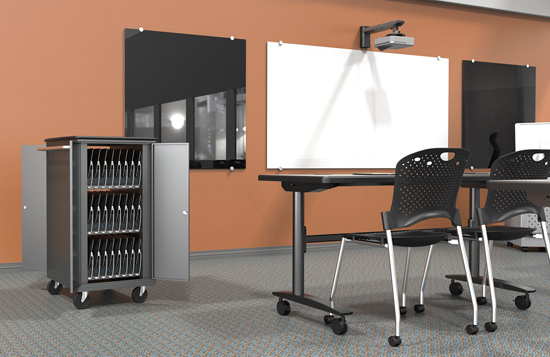
Image courtesy of MooreCo Inc.
This classroom charging station for tablets exemplifies how technology is changing the environment for learning, teaching, and classroom set-up. It’s conceivable that students will no longer need large backpacks to carry heavy textbooks, but may primarily access their books and multimedia learning materials from their tablets.
When classrooms are stiff and boring, students do not learn. That is the assessment of research by the Canadian Center of Science.
“More often than not, learning environments are uninteresting and uninviting,” states a report titled Quality Learning Environments: Design-Studio Classroom.iv
However, research suggests that an intelligent, thoughtful interior design improves both the functionality of a learning environment and also increases the confidence of teachers and learners.
The report continues: “The interior design of spaces such as offices, dining halls, libraries, auditoriums and classrooms should satisfy the minimum requirements of making these spaces more functional, healthier and more enjoyable.”
The lack of proper design actually causes harm, the report states. “Students and instructors suffer from interior problems of classrooms such as inadequate lighting, noise, glare, poor air quality, inappropriate temperature, uncomfortable seats and inflexible seating arrangement.”
According to the report, “The classroom is the most important area in a school. It is an environment that includes various aspects such as psychological, cultural, social and physical. It is where students and teachers spend a large amount of their time and, hence, it is an environment that is assumed to promote a reasonable level of concentration in learning activities such as discussing, reading, drafting, drawing, writing and practicing. Designers ought to pay enough attention to environmental aspects when designing classroom environments. They should create a human-centered environment that supports teaching/learning processes and enhances students’ and instructors’ performance.”
Also offering research on the importance of the classroom environment is the Advanced Learning Technologies (ALTEC) project at the University of Kansas Center for Research on Learning.
“The size of the classroom and interior areas, the colors of the walls, the type of furniture and flooring, the amount of light, and the room arrangement all influence how students learn,” the project emphasizes. “Thoughtful arrangement of the indoor and outdoor environments will support learning goals for students.” Indeed, ALTEC offers an online tool, dubbed “Classroom Architect,” for teachers to experiment with the layout of classrooms.v
According to an article by James Seaman, AIA, LEED AP, an associate with TMP Architecture, “Considering multiple learning-style profiles, an agile learning environment provides flexibility, adaptability and a variety of learning environments on demand. In other words, yesterday’s typical 30-by-30 classroom for 30 students and one teacher doesn’t cut it anymore.”
“Teachers today must be able to vary their instruction in response to a student’s individual learning preferences,” Seaman continues. “Differentiated instruction expert and author Carol Ann Tomlinson states that teachers generally have the ability to adjust and adapt four factors: content, process, product and the learning environment itself for creating the best learning experience. If the classroom design is not agile, the space cannot adapt to an individual effortlessly and expediently. Moveable components should be emphasized.”vi
According to ALTEC, “There is no one way to arrange a classroom. Room arrangement will differ according to the ages and previous experiences of the students, the background knowledge of the teachers and their willingness to experiment with new ideas. The goal is to create an environment for students that will nurture their explorations, language and ideas. In planning their room environment, teachers should act on what they know about children and their development.”
As ALTEC further states, “The types of materials in a classroom and the way in which they are organized convey important messages to students. A room that is attractive, cheerful, orderly and filled with interesting objects conveys the message: ‘This is a comfortable place where you can explore, feel safe and learn.’ Teachers who are aware of the power of the environment are able to arrange indoor and outdoor spaces to convey the messages they want students to receive.”
ALTEC suggests that environments that promote learning include various types of spaces for groups, such as rugs and tables, that:
• Provide space for work.
• Promote student-to-student interaction in small groups.
• The spaces of the classroom may be used flexibly to allow additional staff members to work with students as needed.
• Create small, well-defined, student-friendly/cozy spaces that encourage interactions.
These small, well-defined spaces will assist with learning that:
• Is more creative and encourages behaviors that are productive.
• Highlights individual concepts such as science or writing.
• Incorporates language and literacy development within each space.
The domino effect on behavior, ALTEC says, will demonstrate more cooperation between students, more on-task behavior and fewer behavioral problems.
How Furnishings in Classrooms Can Add to a Superior Learning Environment
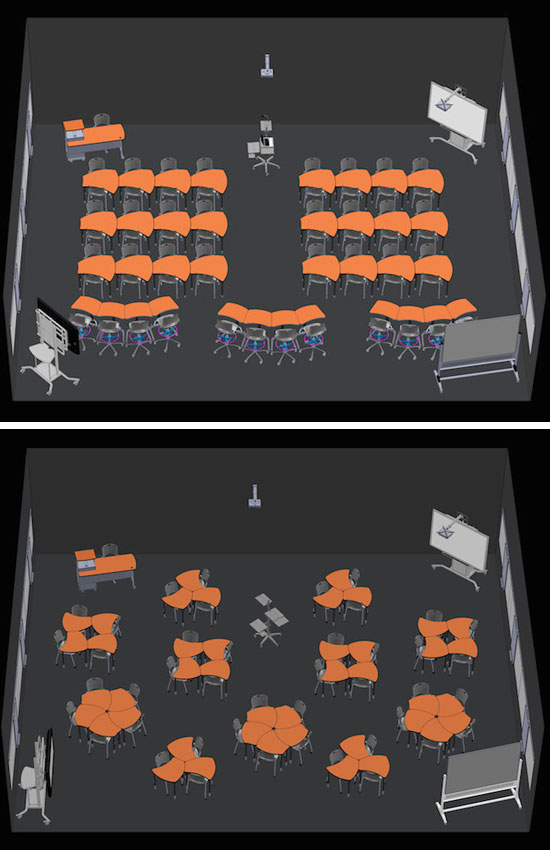
Illustrations courtesy of MooreCo Inc.
Two configurations for a 1,000-square-foot classroom. In the top image, the classroom is set up for a lecture environment, with all chairs facing the front of the room and the teacher or lecturer. In the bottom image, the desks and chairs are set up for small groups and teamwork activities. Configurations include three desks, four desks and five decks.
According to the report from the Canadian Center of Science, “Supportive space layouts with flexible seating arrangements enable different patterns of interaction, connect people with each other, and facilitate collaboration and teamwork.”
But, the report warns, “Unsupportive layouts, however, decrease such connection and interaction. Spaces that discourage interaction patterns are considered dull, empty, huge and meaningless. One example of such a notion is a back-to-back seating arrangement that prohibits teamwork and collaborative learning in classroom environments. Yet, seating arrangement in design-studio classroom is considered supportive when interaction among students/students and students/instructors is encouraged and collaborative learning is ensured.”
“Educational institutions ought to consider the importance of learning environments and their impact on the teaching/learning process; they should provide appropriate and supportive physical settings. The way the classroom is designed, according to Herman Miller, Inc., affects students’ inspiration, concentration, behavior, well-being and performance. Well-planned learning environments, in this regard the design-studio classroom, with flexible and comfortable furniture, appropriate lighting and temperature will positively support teaching/learning experience.”
Studio Configuration in Japan
According to the research on 21st-century education by the Rand Corporation discussed earlier, Japanese educators are trying out an experimental learning system called the “studio learning,” which is designed to teach students to think, analyze and question. These are all skills they will need in the real world.
In the studio system, small pods of students work to solve a problem. It could be an engineering problem, or something to do with robotics, or technology or another discipline.
As the pods of student work through the problems, the other students observe the process. An analogy would be a studio artist or studio musician working on a project as others observe.
When the problem is worked through in the classroom, the observers query each team with questions such as: Why did you solve it in this way? Did you consider other solutions? And so on.
The ability to easily configure the classroom for a studio learning session would be a great benefit to the teaching technique. Ironically, because the studio teaching method requires a lot of students—both as team members and observers—some Japanese educators worry about class sizes getting too small (which is often the holy grail of U.S. teachers) because fewer students means fewer new and innovative ideas to discuss and debate.
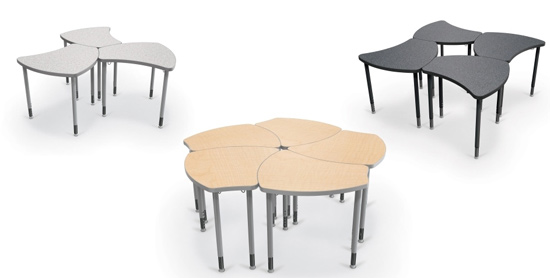
Flexible desk configuration is key to encouraging collaboration. Here are some desk layout scenarios.
Desk Layout Options
Independent study or learning—The single desk configuration is for independent study when students need to focus on their own projects, like taking tests. It’s also useful for lining up desks to face in one direction to watch a presentation, a video or listen to a speaker.
• Pairs of students —some exercises and study plans call for students to work in pairs, perhaps to solve a problem. Two desks joined provide a physical unit that helps students focus on each other rather than the rest of the class.
• Pods of students—in certain cases, a learning exercise calls for pods of students to work together. This could be anywhere from three to 10 or more students. When designs are easily arranged into the pod configuration, students can focus on their own teams.
• Team setting—a pod of four students.
• Project-based setting—a pod of five students.
• Advisory setting—a pod of three students.
• Stadium setting—for lectures.
• TEAL (Technology Enhanced Active Learning)—a pod of nine students.
Configuration for STEM Teaching
STEM is an acronym for Science, Technology, Engineering and Math. A great movement is underway in the United States to teach these four subjects in relation to each other, rather than as separate, unrelated subjects.
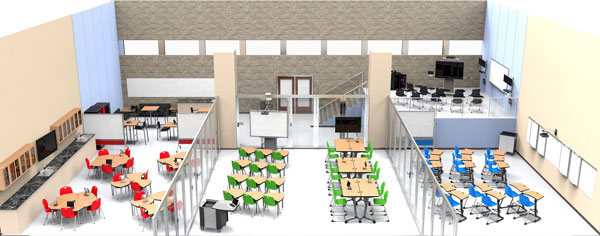
Illustration courtesy of MooreCo Inc.
These various STEM classrooms are set up for lecture style seating and various teamwork seating arrangements. Often, computer stations are included. The key for new learning environments is the ability to easily reconfigure classrooms according to the needs of the lessons, and to foster connections between the teacher and students, and between students.
In a STEM classroom, there are typically three distinct areas that make up the learning environment: traditional lecture style seating, teamwork seating and computer stations, paralleling the way forward-thinking technology and engineering businesses operate.
“By coordinating science and math courses with technology and engineering courses, teachers can give students a better understanding of the world in which they live,” states the National Science Teachers Association (NSTA).vii “Few of today’s students understand the way in which these fields benefit our society or the variety of career opportunities that are available to them.”
Making Learning Relevant to Real Life via Sports-Themed Videos
In addition, students need to connect what they are learning in their classroom with what is happening in their world today. Sports-themed educational videos have been created by NBC in association with the National Science Foundation. Rather that trying to get students to leave their sports obsession at the door of the classroom, why not tap into that for a high-powered learning experience?
Sports-themed topics and videos include:
Science and Engineering of the 2014 Olympic Winter Gamesviii
• Stability & Vibration Damping in Alpine Skiing
• Shani Davis & Engineering Competition Suits
• Science of Ice
• Olympic Movement & Robotic Design
• Building Faster & Safer Bobsleds
Science of NFL Footballix
• Pythagorean Theorem
• Kinematics—Position, Velocity & Acceleration
• Nutrition, Hydration & Health
• Projectile Motion & Parabolas
• Newton’s First Law of Motion
To make it possible to teach such multidisciplinary topics, classrooms should be set up accordingly.
STEM-oriented classrooms need enhanced technology and a flexible set up.
Classroom Configuration for STEAM Teaching
STEAM is a similar acronym to STEM, with the addition of the arts, as in Science Technology Engineering Arts Mathematics.
With the arts involved, STEAM educators aim to “bring FUNctional literacy to all. It promotes bridging the gap between business and educational goals to create a more productive and sustainable global culture based on teamwork. This educational framework is for all disciplines and types of learners with the goal of being more engaging and naturally successful for all members of any educational system.x”
STEAM was developed in 2006 by Georgette Yakman, then a Master’s graduate from Virginia Polytechnic and State University who went on to use the method as a full-time middle-school and high-school teacher and educational consultant.
As with STEM, the STEAM educational system requires a rethinking of classroom layout and should include flexible furniture for lecture, independent study and collaborations.
Classroom Configuration for TEAL Teaching
A TEAL (Technology Enhanced Active Learning) classroom is designed for a combination of teaching/learning activities: lecture and recitation, lab work, and collaboration opportunities.
TEAL was developed in the 1990s after an MIT physics professor noticed that teaching freshmen students in a style termed “interactive engagement” produced better results than the typical lecture format. With funding from several sources, two 3,000-square-foot TEAL classrooms were set up as a prototype. In the reconfigured classroom, the instructor’s workstation is in the center of the room, surrounded by 13 round tables, each seating nine students. There are 13 whiteboards and eight video projectors with screens dotting the room’s perimeter. Groups are formed by mixing students with various degrees of knowledge and a group leader to facilitate peer instruction.
In a typical class session, the instructor gives a 20-minute lecture that is interspersed with pencil and paper exercises, discussion questions and creative visualizations. Instructors no longer lecture from a fixed position, but move around the classroom with a wireless microphone, interacting with students.
The impact of the learning style has been remarkable. According to MIT:xi
“A variety of assessment techniques used by TEAL have shown the effectiveness of interactive engagement across a range of student backgrounds. The teaching methods used in the TEAL classroom produced about twice the average normalized learning gains for low-, intermediate- and high-scoring students when compared to traditional instruction. These findings replicate the results of studies performed at other universities.”
Emerging Technology and Furniture Elements for High-Impact Classrooms
According to studies, reports and experience, a highly functioning classroom needs far more technology and flexible furniture than ever before. Here are some examples of what should be included in a classroom for modern learning:
Full Wall Magnetic Whiteboards
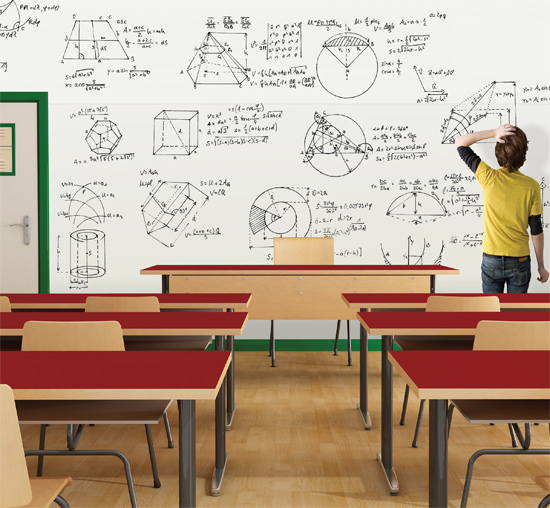
Image courtesy of MooreCo Inc.
Full wall magnetic whiteboards expand the learning environment.
Sometimes called share walls, full wall magnetic whiteboards offer an array of options for mounting styles and configurations, from horizontal, vertical, railroad, framed and unframed, to suit the space, and can be overlapped or butted together for nearly invisible seams in any location. They can also be installed on curved walls.
Full wall magnetic whiteboards expand the learning environment so that students around the room, and in different seating configurations, can interact with the board and the students using it. Unlike a traditional classroom setting, the vertical learning surface is not limited to one small space.
Plus, high-quality whiteboards are stain resistant, allowing writers to use vibrant markers that can cause staining on whiteboards of substandard materials. The new marker boards can be erased with a microfiber cloth and tend not to leave the ghosting effect so prevalent in many classrooms.
Mobile Interactive Whiteboards
Reinforcing the functionality of flexible classrooms, mobile whiteboards allow a vertical, connected interactive whiteboard to move according to the classroom configuration. A side table holds a laptop. When the stand adjusts up and down, it can be used for students of various ages, sizes and abilities (i.e. for those sitting in wheelchairs).
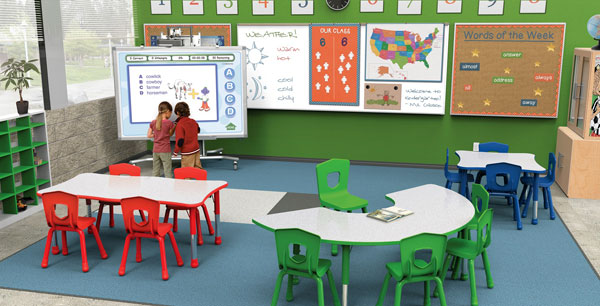
Image courtesy of MooreCo Inc.
New technology allows for whiteboards that are both mobile and interactive.
Mobile Workstations
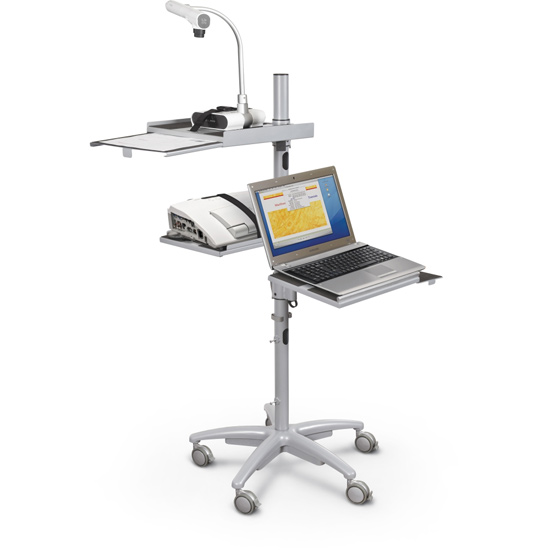
Image courtesy of MooreCo Inc.
A mobile workstation allows a teacher to teach effectively throughout the classroom, including one-on-one sessions with students or small groups.
This could be considered a teacher’s mobile technology “stick,” allowing the teacher to move around the room with ability to use both a document camera and projector in her or his laptop. It can also be used as a mobile projector cart for transporting AV equipment from room to room, and also for use in a smaller area, furthering the flexible theme of the new learning environments.
Modular Teacher’s Desks
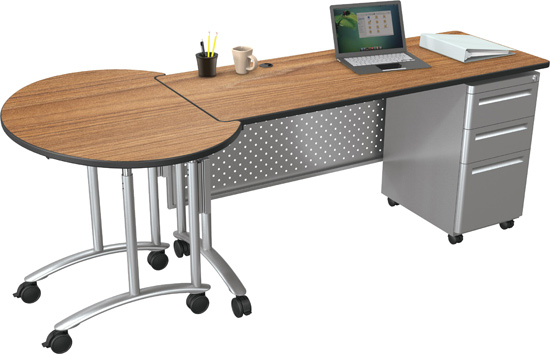
Image courtesy of MooreCo Inc.
Flexible desk options allow teachers to configure the station that is right for their individual needs and requirements.
No longer is the teacher’s desk a heavy immovable wooden monolith at the front of the room. Instead, the teacher in the modern learning environment should be able to create a custom configuration according to teaching needs and style. Modular desk units include a single desk on casters, conference-size desk, return desks, height-adjustable desks, podium desks with built-in lectern, an AV panel, filing cabinet, USB chargers and other features.
Height-Adjustable Desks
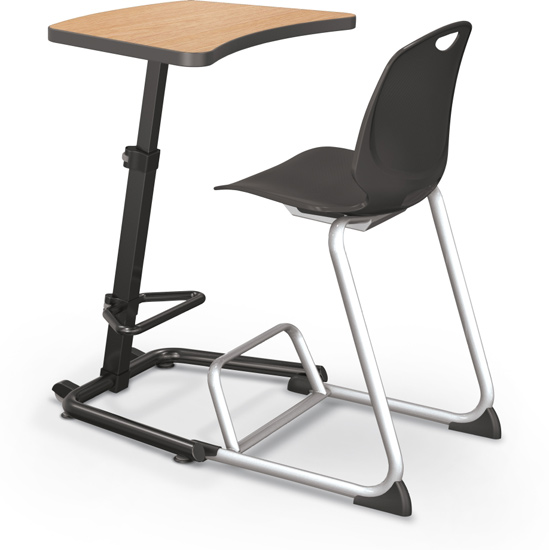
Image courtesy of MooreCo Inc.
Desks that allow students to sit or stand helps them keep focused.
A Mayo Clinic studyxiii took the concept of flexible seating arrangements one step further and asked: “Do children really need to sit while they learn?” To test this theory, researchers designed a “chairless” school, complete with standing desks.
It’s becoming clearer that sitting for long periods of time is detrimental to human health. To ask students to stay seated for long hours is teaching them bad habits. While perhaps far off to imagine, in the future every classroom desk would be adjustable for sitting and standing alternations, which would actually be ideal.
According to the National Education Association, kids who fidget, especially those with ADHD, attention-deficit/hyperactivity disorder, need to move around to focus on a complicated mental task. Standing desks provide the movement needed.
Adjustable Perch Stools
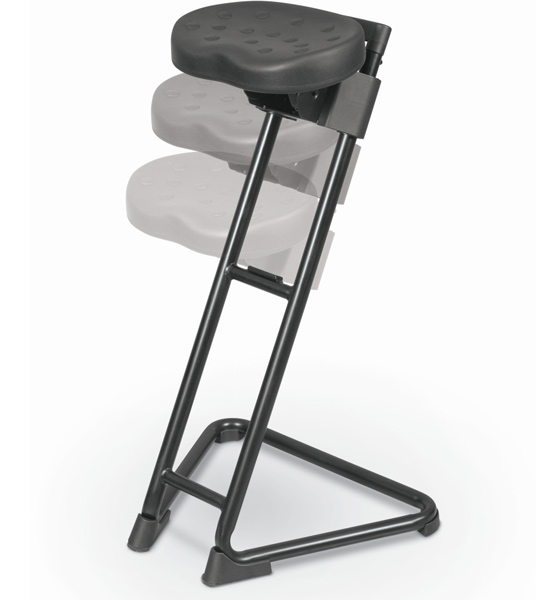
Image courtesy of MooreCo Inc.
Adjustable perch stools allow for easy use of a sit/stand desk.
Perch stools can be used with adjustable height desks. Varying between standing and sitting helps students maintain focus, burns calories, improves circulation and builds fitness.
Mobile Partition and Display Panels
Flexible space may require partitions at times. This option allows for more display space for student achievements.
Green and Sustainable Elements in 21st-Century Schools and Classrooms
In 21st-century schools and classrooms, architects and the AIA continue to lead the green charge.
“When we transform the physical environment of learning institutions, we transform the way students, teachers and communities engage with their world,” states the Center for Green Schools website. “A green school is an interactive teaching tool, imparting lessons of stewardship and kinship, preparing students so that they can lead productive lives.”xiv
According to U.S. Green Building Council: “School buildings can enhance a student’s ability to learn by keeping them healthy, attentive and present.”
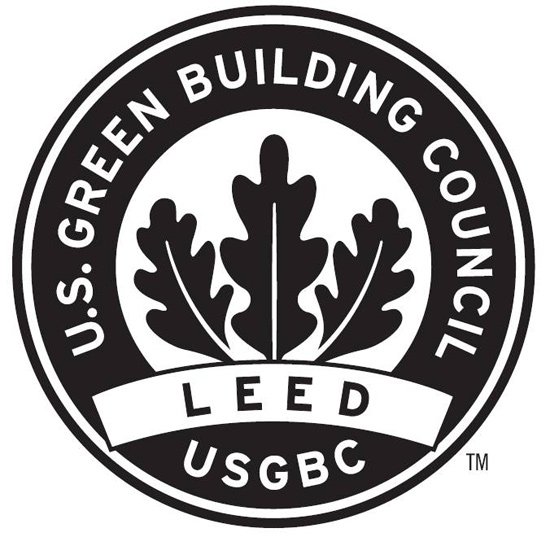
These are some strategies suggested by USGBC for designing schools that can earn LEED or other green building certifications:
• Removing toxic materials and products from places where children learn and play.
• Controlling exposure to dust and pollen, which improves the health of students, faculty and staff, potentially decreasing sick days.
• Giving access to daylight and outdoor views to building occupants, which has been shown to heighten participation, lessen distraction and encourage learning. Studies have shown that when deprived of natural light, children’s melatonin cycles are disrupted, thus likely having an impact on their alertness during school.
• Emphasizing the importance of acoustics, which are fundamental to absorbing and retaining information. There is a clear connection between proper acoustic design in schools and acoustic performance from students.
• Providing access to thermal controls like thermostats or operable windows, which teachers report give higher levels of comfort in their classrooms.
For furnishing a classroom using best environmental practices, look for evidence of a furnishing manufacturer’s green commitment. This could include:
Cradle-to-Cradle Product Certification—certifies a product’s use of healthy materials and eco-intelligent design. Products gaining this certification must meet standards for Material, Health and Reutilization; Renewable Energy; Water Stewardship, and Social Responsibility.

GreenGuard Indoor Air Quality Certified — According to the Environmental Protection Agency (EPA), indoor air pollution is two to five times worse than outdoor air pollution. This is important to know as we spend up to 90 percent of our time indoors. The EPA also reports that 60 percent of homes and 30 percent of commercial buildings are classified as “sick.”xv
GreenGuard certified products must meet stringent requirements for chemical emissions and toxicity. They are screened for thousands of chemicals, irritants, carcinogens and reproductive toxins.
The GreenGuard Children & Schools certification program is for places where children and others play, work and reside. It offers even stricter certification criteria. It is referenced by both the Collaborative for High Performance Schools (CHPS) and LEED.
Conclusion
Architects and specifiers have long led the way toward healthier and more functional buildings and interiors. Understanding how schools and teaching need to change, and are changing, puts the architect in a better position to design for the future, rather than repeating the past.
According to the National Center for the Twenty-First Century Schoolhousexvi at San Diego State University:
“If they have done their job well, planners/designers have even considered the relationships between spaces within the building. The aim should be a synthesis of program maximizing a unity of form and purpose. If carefully conceived, the separate spaces will reinforce each other physically and aesthetically. They will contain the best of the past, make safe the present and be flexible enough to accommodate the future.”
In this course, we looked at why and how schools are changing in the 21st century, and how classrooms are evolving into better learning environments. We examined in detail how flexible furnishings specified for classrooms add to superior learning. And finally, we looked at the green and sustainable elements pertinent to classrooms in the 21st century.
Endnotes
i http://www.c-span.org/video/?321025-2/washington-journal-elementary-secondary-education-act-1965
ii http://www.rand.org/multimedia/audio/2012/09/05/lessons-science-learning.html
iii http://www.forbes.com/sites/susanadams/2013/05/17/why-the-open-office-fails-and-a-solution/
iv http://www.ccsenet.org/journal/index.php/ach/article/view/18473
v http://classroom.4teachers.org
vi http://coe.sdsu.edu/edl/schoolhouse/documents/MASALeader_Fall2010_Seaman.pdf
vii http://www.nsta.org/publications/archive-stem.aspx
viii http://www.nbclearn.com/portal/site/learn/science-of-the-summer-olympics
ix http://www.nbclearn.com/portal/site/learn/science-of-nfl-football
xi http://web.mit.edu/edtech/casestudies/teal.html
xii http://www.domainpdf.com/detail-pdf/teaching-for-learning-a-philosophical-approach-to-classroom
xiii http://psychcentral.com/news/archives/2006-03/mc-mco031006.html
xiv http://www.centerforgreenschools.org/leed-for-schools.aspx
 |
MooreCo Inc., has been manufacturing high quality visual communication products, technology products and school and office furniture for decades. Today, MooreCo is committed to modern design, understanding of modern classrooms and workspaces and flexibility for future trends. The MooreCo goal is to achieve operational excellence in all aspects of procurement, manufacturing, customer order fulfillment and environmental stewardship while designing products for safe, healthy and sustainable environments. www.moorecoeducation.com |
